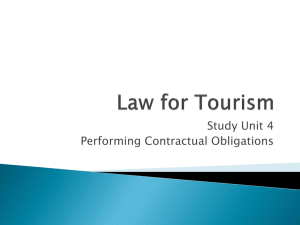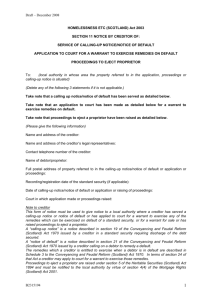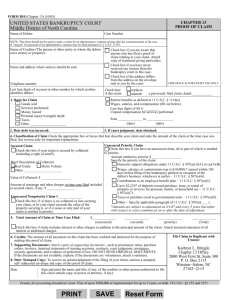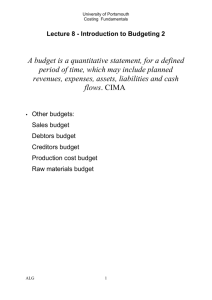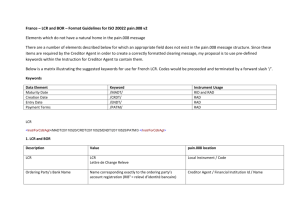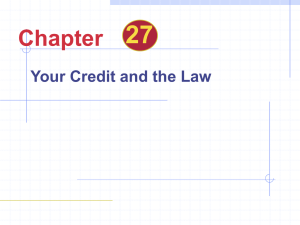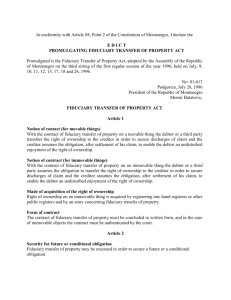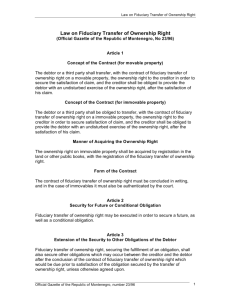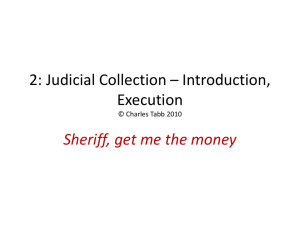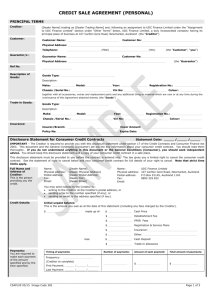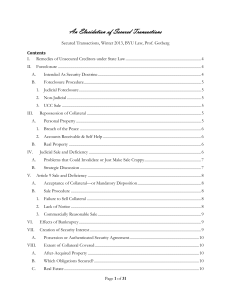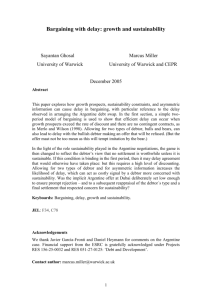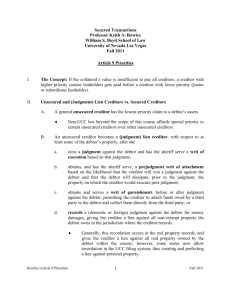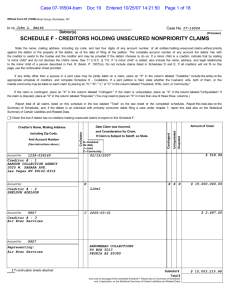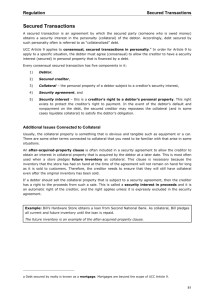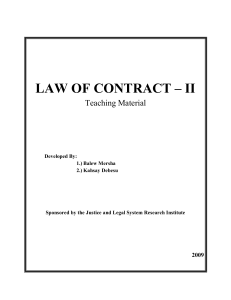Chapter 11 Issues - facultyfederaladvocates
advertisement
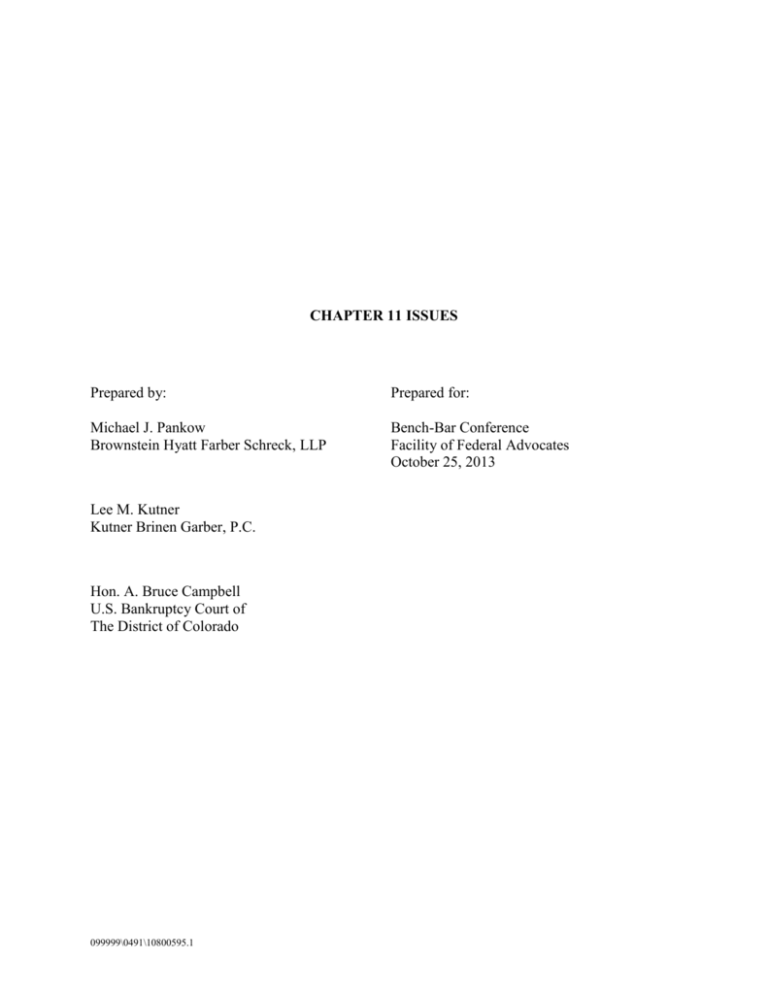
CHAPTER 11 ISSUES Prepared by: Prepared for: Michael J. Pankow Brownstein Hyatt Farber Schreck, LLP Bench-Bar Conference Facility of Federal Advocates October 25, 2013 Lee M. Kutner Kutner Brinen Garber, P.C. Hon. A. Bruce Campbell U.S. Bankruptcy Court of The District of Colorado 099999\0491\10800595.1 I. SECTION 1111(b) ELECTION A. Operation Pursuant to normal operation of Bankruptcy Code section 506(a), the claim of an undersecured creditor is bifurcated into secured and unsecured claims. A section 1111(b)(2) election allows a creditor to opt out of that treatment. If a creditor makes an 1111(b) election, it will retain its lien for the entire face amount of its debt. In exchange, it will forego the unsecured claim it would otherwise receive pursuant to section 506(a). In a plan, a creditor who properly makes the 1111(b) election must receive a payment stream with payments (without regard to interest) that total the face amount of the debt. The present value of those payments must equal the value of the collateral. Example: Creditor holds a note secured by real estate. $1 million is owing on the note. The real estate collateral is worth $550,000. Pursuant to section 506(a), the claim would normally be split into a $550,000 secured claim and a $450,000 unsecured claim. In a plan, the creditor would be entitled to a note in the principal amount of $550,000 with fair and equitable terms. Its lien after plan confirmation would secure only the $550,000. The creditor would also have rights of voting and distribution in respect of its $450,000 unsecured claim. Upon an 1111(b) election, the plan must provide that the creditor retains its lien for the entire $1 million. The creditor would receive no distribution or voting rights with respect to the $450,000 deficiency. Instead, the creditor would be entitled to receive periodic payments of a $1 million over time so long at the payments have a present value of $550,000. E.g., payments of $50,000 per year for 20 years would comply, but only if the court finds that payment stream to have a present value of $550,000. That in turn depends upon what the Court finds to be the appropriate discount rate. How is the interest rate determined? Can the debtor prepay the portion of the debt equal to the value of the collateral and leave the balance of the claim secured by the property? B. Pros 1. A secured creditor should consider the election if it believes the collateral will increase in value 2. Lien must be satisfied upon the sale, foreclosure, or refinance. Upon any of those events, the creditor would be entitled to its full $1 million. 3. The election, if available, can provide significant leverage for a junior lien position. 099999\0491\10800595.1 1 C. Cons Despite the apparent benefits, actual section 1111(b) elections remain rare. This is likely because the creditor gives up the substantial benefits and leverage associated with its deficiency claim. 1. By giving up unsecured vote, the creditor often would give up the right to block acceptance by the unsecured class and thereby force the debtor to comply with the absolute priority rule (or new value exception) and to find another accepting class for purposes of Bankruptcy Code section 1129(a)(10). 2. Creditor also gives up distribution on unsecured claim. 3. In a 203 No. LaSalle auction for the new equity, the creditor may be able to effectively “credit bid” its unsecured claim. A creditor making the election gives this up. D. May a creditor revoke election? 1. Same plan. 2. An election probably does not apply to a different plan, i.e., it is probably plan specific. E. II. When Election not Permitted 1. Debt is contractually recourse and property is to be sold under Plan 2. Lien is of inconsequential value SALE MOTIONS A. Stalking Horse Bid protections 1. Expense Reimbursement. 2. Break-up Fee. 3. Match Right 4. Other rights in procedures All of these protections are designed to protect the party making the stalking horse bid. Expense reimbursements are typically designed to allow the bidder to recover out of pocket costs and expenses incurred in making the bid. These are generally allowed. Break up fees are more of a challenge in getting approval. They must be found to be reasonable. A delicate balance must be drawn to protect the bidder and provide incentive in attracting a stalking horse bidder yet not discouraging competitive bidding that may benefit the estate. What limitations are people seeing in gaining approval of these provisions? What procedures are judges using? 099999\0491\10800595.1 2 B. Lease Assignments With Sale 1. When Stalking Horse selects prior to sale motion- Generally the leases and contracts to be assumed are pre-selected and the amount of the cure must be included in the bid if the debtor does not otherwise have the funds to cure. How does this impact competitive bidders if they select a different group of contracts. 2. When Stalking Horse does not select prior to sale motion- Does the motion to approve the sale contain a procedure for the subsequent assumption and assignment of leases and contracts. How are the cure amounts to be funded. How will a competitive bid be evaluated. 3. Process to accommodate competing bids. The comparison of competitive bids can become fairly complicated when each bidder is seeking to obtain different contracts and leases. It is generally advisable to fix a definite procedure prior to the solicitation of competing bids. C. One Motion or Two? 1. Lease Assignments in same motion as “core” section 363 motion or separate? 2. Bid Procedures in same motion or separate? What are people’s experiences with using one or two motions with respect to the sale of assets and the assignment of leases and contracts. D. “Private Sale” The private sale process to a preselected buyer may be used but still requires court approval. Generally, if objections are filed the debtor will need to justify and support the private sale. This may involve evidence showing that the market has been evaluated or tested as to the selected assets and will not provide a higher sale price. Alternatively the debtor may have obtained relatively recent appraisals demonstrating that the sale price is fair and reasonable. Have people used this process or seen it used and what results are encountered? Do people see more objections to the private sale? III. PLAN ISSUES A. Disclosure Statement in Small Business Cases. §1121(e)(1) is the exclusivity period for small business cases. It provides that only the debtor may file a plan for the first 180 days of the case, unless extended or the court orders otherwise. §1121(e)(2) goes on to provide that the plan and a disclosure statement, if any, shall be filed not later than 300 days following the entry of the order for relief. These provisions appear to mean that while the debtor may enjoy the exclusivity period for the first 180 days of the case, a plan does not have to be filed within this period. One court interpreting this provision has held that the requirement that a plan be filed within 300 days following the entry of the order for relief applies only to a plan filed by the debtor and that there is no statutory deadline for filing a reorganization plan by any party in 099999\0491\10800595.1 3 interest other than the debtor. In re Florida Coastal Airlines, Inc., 361 B.R. 286, 290-91 (Bankr. S.D. Fla. 2007). i. Timing is everything in these cases. The plan confirmation hearing must occur within 45 days of the date on which the plan is filed. The disclosure statement may be conditionally approved and final approval may occur at the confirmation hearing. However, a conditionally approved disclosure statement must be mailed to creditors no later than 25 days before the confirmation hearing. Assuming the plan and disclosure statement are filed on the same day, the disclosure statement must be conditionally approved and mailed within 20 days. Our Local Rules are designed to get you around this problem. They allow for the filing of the disclosure statement with the plan attached as an exhibit. This eliminates the 45day problem and gives you time to gain conditional or final approval of the disclosure statement at which time the plan can be filed and the 45-day period commenced. What happens when you bump up to the 300 day requirement for filing the Plan? B. Reservation of Claims and Causes of Action. A number of cases indicate that if the disclosure statement does not describe or discuss the claims which a debtor intends to pursue and the plan is confirmed, the claims may be lost. Various cases test the limits to this requirement and the amount of discussion that may be required to preserve the claims. Has anyone seen a claim lost due to a failure to disclose? C. Absolute Priority Rule in Individual Cases. The fair and equitable test with respect to gaining confirmation of a plan over the dissent of a class of unsecured creditors has been modified with respect to individuals. §1129(b)(2)(B)(ii) allows the debtor to "retain property included in the estate under section 1115". While a split exists among courts as to whether this language eliminates the absolute priority rule in individual cases, this question has been answered in the Tenth Circuit. The answer is that the absolute priority rule continues to exist. In re Stephens, 704 F.3d 1279 (10th Cir. 2013). While the rule is subject to certain limitations, the decision does present a number of problems for debtors. The larger looming question is how does one confirm a plan for an individual when the vote of the unsecured creditor class cannot be obtained? 099999\0491\10800595.1 4


